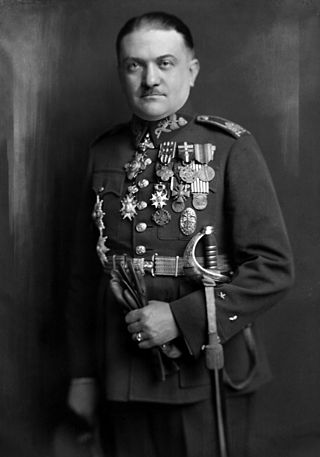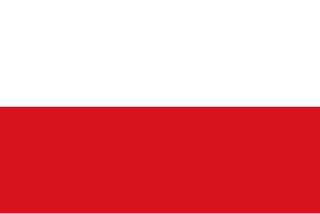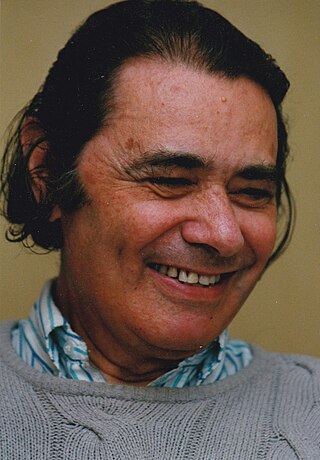Related Research Articles

The Sudetenland is the historical German name for the northern, southern, and western areas of former Czechoslovakia which were inhabited primarily by Sudeten Germans. These German speakers had predominated in the border districts of Bohemia, Moravia, and Czech Silesia since the Middle Ages. Since the 9th century the Sudetenland had been an integral part of the Czech state both geographically and politically.

The military occupation of Czechoslovakia by Nazi Germany began with the German annexation of the Sudetenland in 1938, continued with the creation of the Protectorate of Bohemia and Moravia, and by the end of 1944 extended to all parts of Czechoslovakia.

Alois Eliáš was a Czech general and politician. He served as prime minister of the puppet government of the German-occupied Protectorate of Bohemia and Moravia from 27 April 1939 to 27 September 1941 but maintained contact with the government-in-exile. Because of his participation in the anti-Nazi resistance, he was the only head of government who was murdered by the Nazis during World War II.

Theresienstadt Ghetto was established by the SS during World War II in the fortress town of Terezín, in the Protectorate of Bohemia and Moravia. Theresienstadt served as a waystation to the extermination camps. Its conditions were deliberately engineered to hasten the death of its prisoners, and the ghetto also served a propaganda role. Unlike other ghettos, the exploitation of forced labor was not economically significant.

German Bohemians, later known as Sudeten Germans, were ethnic Germans living in the Czech lands of the Bohemian Crown, which later became an integral part of Czechoslovakia. Before 1945, over three million German Bohemians constituted about 23% of the population of the whole country and about 29.5% of the population of Bohemia and Moravia. Ethnic Germans migrated into the Kingdom of Bohemia, an electoral territory of the Holy Roman Empire, from the 11th century, mostly in the border regions of what was later called the "Sudetenland", which was named after the Sudeten Mountains.

The history of the Jews in Prague, the capital of today's Czech Republic, relates to one of Europe's oldest recorded and most well-known Jewish communities, first mentioned by the Sephardi-Jewish traveller Ibrahim ibn Yaqub in 965 CE. Since then, the community has existed continuously, despite various pogroms and expulsions, the Holocaust, and subsequent antisemitic persecution by the Czech Communist regime in the 20th century.

The First Czechoslovak Republic, often colloquially referred to as the First Republic, was the first Czechoslovak state that existed from 1918 to 1938, a union of ethnic Czechs and Slovaks. The country was commonly called Czechoslovakia, a compound of Czech and Slovak; which gradually became the most widely used name for its successor states. It was composed of former territories of Austria-Hungary, inheriting different systems of administration from the formerly Austrian and Hungarian territories.

The history of the Jews in the Czech lands, historically the Lands of the Bohemian Crown, including the modern Czech Republic, goes back many centuries. There is evidence that Jews have lived in Moravia and Bohemia since as early as the 10th century. Jewish communities flourished here specifically in the 16th and 17th centuries, and again in the late 19th and early 20th centuries. Local Jews were mostly murdered in the Holocaust, or exiled at various points. As of 2021, there were only about 2,300 Jews estimated to be living in the Czech Republic.

The expulsion of Germans from Czechoslovakia after World War II was part of a series of evacuations and deportations of Germans from Central and Eastern Europe during and after World War II.

Siegfried Taub was a Sudeten German Jewish politician from Czechoslovakia. Taub was the general secretary of German Social Democratic Workers Party in the Czechoslovak Republic (DSAP) from 1924. He belonged to the Moravian triumvirate, with party chairman Ludwig Czech and newspaper editor Wilhelm Niessner, that came to dominate the party leadership from the mid-1920s. Taub served as deputy speaker of the Czechoslovak parliament.

Pavel Bergmann was a Czech historian, philosopher, a signatory of the Charter 77 manifesto, and a founding member of the Civic Forum.

Alfréd Meissner was a Czechoslovak politician and member of the Social Democratic Party in the First Czechoslovak Republic. He was elected to the National Assembly and served twice as Minister of Justice and twice as Minister of Social Welfare of the republic. Following the German occupation of Czechoslovakia during the Second World War, he was deported to the Theresienstadt concentration camp. He survived the Holocaust, and after the war he returned to Prague where he died at the age of 79.
Livia Rothkirchen was a Czechoslovak-born Israeli historian and archivist. She was the author of several books about the Holocaust, including The Destruction of Slovak Jewry (1961), the first authoritative description of the deportation and murder of the Jews of Slovakia.
The Curatorium for the Education of Youth was an organization in the Protectorate of Bohemia and Moravia that provided athletic and cultural activities for youth ages ten to 18. Though created at the impetus of officials in the German-backed Protectorate government, it evolved to promote a distinctive form of "Reich-loyal" Czech nationalism that was viewed with concern by some quarters of the Nazi Party. Following World War II, it was banned as a fascist organization and its principal leaders put on trial.

Sudeten German uprising in September 1938 was a spontaneous rebellion of Sudeten Germans against Czechoslovak authorities in Sudetenland, but at the same time, an organized action orchestrated by Sudeten German Party (SdP) chaired by Konrad Henlein. Therefore, the uprising is also referred to as the Henlein's coup.

Marianne Golz-Goldlust was an Austrian-born opera singer and actress. She maintained a successful career in eastern Europe during the early 1920s, later moving to Prague, Czechoslovakia, and becoming a theatre critic. She married Jewish journalist Hans Goldlust in 1929. When Hans was arrested by Nazis in 1939, Golz-Goldlust secured his release, helping him and his other relatives escape to England. She stayed in Prague to help the Resistance, a dangerous task which she accomplished by hiding Jewish refugees, smuggling financial resources and information across borders, recruiting new resistance members, and holding resistance meetings at her home.

The Holocaust in Bohemia and Moravia resulted in the deportation, dispossession, and murder of most of the pre-World War II population of Jews in the Czech lands that were annexed by Nazi Germany between 1939 and 1945.

The Holocaust in the Sudetenland resulted in the flight, dispossession, deportation and ultimately death of many of the 24,505 Jews living in the Reichsgau Sudetenland, an administrative region of Nazi Germany established from former Czechoslovak territory annexed after the October 1938 Munich Agreement. Due to harassment and violence, including during Kristallnacht, ninety percent of the Jews had already left the Sudetenland by mid-1939. The remaining Jews were subject to property confiscation and eventually deportation. During the later years of the war, tens of thousands of Jews and non-Jews were forced laborers in a network of concentration camps in the Sudetenland.

Arijský boj was a pro-Nazi Czech-language weekly tabloid newspaper published between May 1940 and May 1945 in the Protectorate of Bohemia and Moravia. Inspired by the Nazi newspaper Der Stürmer, the newspaper made antisemitism its main theme and was also critical of the Czechoslovak government-in-exile. Denunciations published by the newspaper contributed to the isolation of Jews during the first years of the Holocaust in Bohemia and Moravia.
References
- ↑ "FreeBMD Entry Info". www.freebmd.org.uk. Retrieved 2020-10-29.
- 1 2 "Rábl Rudolf". is.cuni.cz. Retrieved 2023-10-05.
- 1 2 Kolumber, David (2023). Rudolf Rabl (*1889 – † 1951) (in Czech). Vydavatelství a nakladatelství Aleš Čeněk. ISBN 978-80-7380-926-3.
- ↑ "Holocaust Survivors and Victims Database -- Dr Jur Rudolf Israel Rabl". www.ushmm.org. Retrieved 2020-10-29.
- ↑ Philologica Pragensia. Československá akademie věd. 1975.
- 1 2 Sudeten Bulletin. Sudeten German Archive. 1959.
- ↑ Library, Harvard Law School (1974). Annual Legal Bibliography. Harvard Law School Library.
- 1 2 Jaksch, Wenzel (1964). Europe's Road to Potsdam. Praeger.
- ↑ Rothkirchen, Livia (2006-01-01). The Jews of Bohemia and Moravia: Facing the Holocaust. U of Nebraska Press. ISBN 978-0-8032-0502-4.
- ↑ "Rudolf Rabl b. 23 Mar 1889 d. 20 Aug 1951: Geneagraphie". www.geneagraphie.com. Retrieved 2024-02-17.